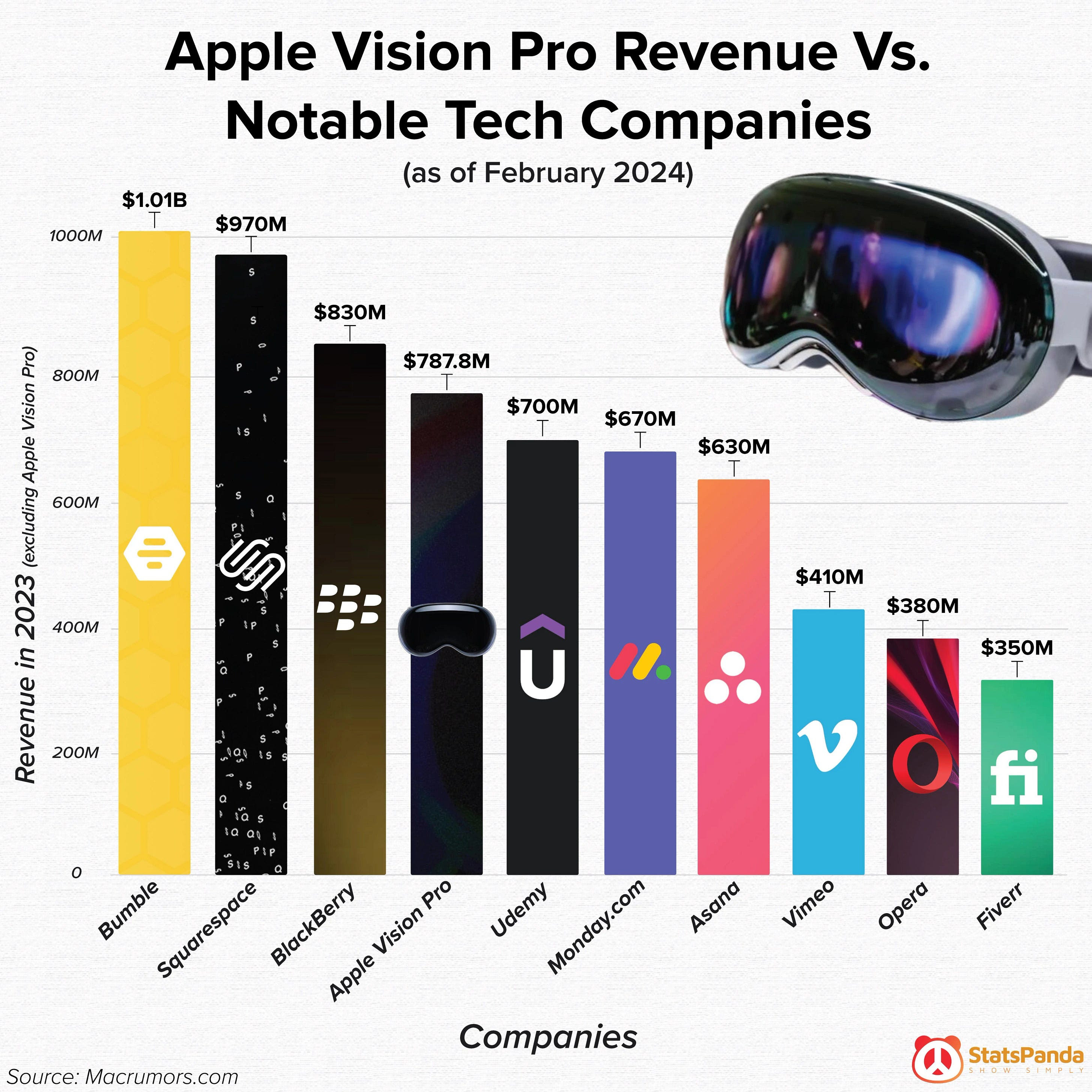
1. Introduction
Apple, a leading multinational technology company, launched the Apple Vision Pro in 2023, marking its entry into the realm of spatial computing and augmented reality (AR) devices. This product represents a significant shift in Apple’s hardware portfolio, combining cutting-edge technology with immersive experiences. This case study explores Apple Vision Pro’s business model, growth strategies, challenges, and market positioning, offering insights for Home School of Business students.

2. Company Overview
- Founder: Steve Jobs, Steve Wozniak, Ronald Wayne
- Founded: April 1, 1976
- Headquarters: Cupertino, California, USA
- Industry: Consumer Electronics, Software, and Digital Services
- Core Products: iPhone, iPad, Mac, Apple Watch, Apple TV, and Apple Vision Pro
- Global Presence: Apple has a significant global presence in more than 100 countries, with millions of devices sold annually.
3. Market Analysis
Market Size: The global AR and VR market was valued at $28 billion in 2021 and is expected to grow at a CAGR of 25% to reach $452 billion by 2030. Apple’s Vision Pro aims to capture a portion of this fast-growing market segment, primarily targeting high-end consumers and developers.
Consumer Behavior: Early adopters of AR/VR products are typically tech-savvy individuals, gamers, and developers. With Apple’s brand power, Vision Pro seeks to reach beyond this niche by offering practical applications for business, entertainment, and creative professionals.
Key Competitors: Meta (Meta Quest series), Microsoft (HoloLens), Sony (PlayStation VR), Google, and various other companies in the AR/VR space.

4. Business Model
Apple Vision Pro is positioned as a premium device, offering immersive AR experiences through a combination of advanced hardware and software integration. Apple’s business model leverages both hardware sales and the ecosystem that surrounds Vision Pro, including apps, content, and services.
Product Range:
- Vision Pro Hardware: A high-end AR device that offers spatial computing, immersive experiences, and enhanced productivity through gesture, voice, and eye tracking.
- Software Ecosystem: VisionOS, Apple’s new operating system, is designed specifically for Vision Pro and offers a new way to interact with apps in 3D space. Existing apps, including FaceTime, Safari, and Photos, have been adapted to function within this environment.
Revenue Streams:
- Hardware Sales: Apple Vision Pro is priced at a premium, starting at $3,499. Hardware sales represent the core revenue stream for Apple, but like other products, Apple uses this device to promote its broader ecosystem.
- App Store and Developer Fees: Developers will create apps specifically for VisionOS, allowing Apple to generate revenue through its App Store by taking a cut of app sales and in-app purchases.
- Services Integration: Apple’s services such as Apple TV+, iCloud, and Apple Arcade are tightly integrated with Vision Pro, encouraging more usage of its subscription-based offerings.
5. Evolution and Growth
Early Beginnings: Apple’s journey into AR began with the introduction of ARKit in 2017, which allowed developers to build AR experiences for the iPhone and iPad. Apple’s Vision Pro represents the culmination of years of research and development into spatial computing.
Expansion into Spatial Computing: Vision Pro goes beyond existing AR/VR headsets by offering spatial computing, allowing users to interact with apps in 3D space. Apple has positioned the device as not only a gaming or entertainment platform but also a productivity tool for creative professionals and business users.
Ecosystem Expansion: Apple Vision Pro’s success will depend heavily on its ecosystem. By encouraging developers to create apps specifically for VisionOS, Apple aims to replicate its success with the App Store and expand its footprint in the spatial computing space.

6. Operational Strategy
Vertical Integration: Apple’s strong focus on vertical integration allows it to control both the hardware and software experience of Vision Pro. Apple designs its own custom chips (such as the M2 and R1 chips used in Vision Pro) and optimizes the hardware for VisionOS, ensuring seamless performance and an immersive user experience.
Product Innovation: Vision Pro introduces several innovations, including advanced eye-tracking technology, high-resolution displays, and an intuitive interface. Users can interact with the device using hand gestures, voice commands, and eye movements, providing a more natural interaction with digital content.
Sustainability: Apple has committed to making its products more environmentally friendly, and Vision Pro follows suit with a focus on sustainable materials and energy-efficient technologies.
7. Financial Analysis
Revenue: Vision Pro’s premium price point of $3,499 will contribute significantly to Apple’s revenue stream, although initial sales volumes are expected to be lower than other flagship products like the iPhone or Mac. Apple is expected to focus on scaling production and bringing down costs over time to increase adoption.
Costs: The development of Vision Pro involved significant R&D investment, with costs related to hardware components (such as high-resolution displays, sensors, and custom chips), software development, and ecosystem expansion. Given the premium pricing strategy, Apple will likely aim for h`igh profit margins per device, although initial production costs may be high.
Profitability: Like other Apple products, Vision Pro is expected to generate strong margins, driven by Apple’s pricing power and ability to scale production. As the platform grows, Apple will benefit from recurring revenue through its App Store and services ecosystem.
8. Marketing and Customer Acquisition
Target Market: Apple Vision Pro initially targets early adopters, developers, and creative professionals who seek cutting-edge AR technology. Over time, Apple is expected to expand its reach to broader consumer markets, including gamers, business professionals, and consumers interested in entertainment and productivity tools.
Marketing Channels:
- Apple Keynotes: Apple’s product launches and keynote events are major marketing platforms, driving global awareness and excitement for Vision Pro.
- Digital Advertising: Apple invests heavily in digital marketing, showcasing the Vision Pro’s features across its website, social media, and third-party platforms.
- In-Store Demos: Apple’s retail stores will play a key role in driving customer interest, offering hands-on demos that showcase the capabilities of Vision Pro.
Customer Engagement: Apple emphasizes user experience in its products, and Vision Pro is no exception. Through intuitive design, ease of use, and seamless integration with Apple’s existing ecosystem, Vision Pro aims to create a strong emotional connection with users.

9. Challenges
High Price Point: At $3,499, Vision Pro is priced well above most competing AR/VR headsets, which may limit its appeal to a niche audience in its early stages. Apple will need to demonstrate the device’s value for consumers to justify the high cost.
Limited Use Cases Initially: While Vision Pro offers impressive hardware, its success will depend on the development of compelling software use cases. Initially, the range of apps and experiences may be limited, which could hinder adoption.
Competition: Apple faces competition from companies like Meta, Microsoft, and Google, all of whom have invested in AR/VR technology. Meta’s Quest headsets, in particular, are priced significantly lower and are already popular among consumers.
Hardware Limitations: Battery life and comfort are critical factors for consumer adoption of wearable devices. Apple Vision Pro’s external battery pack offers limited use before recharging, and the headset’s weight and comfort may be challenging for prolonged use.
10. COVID-19 Impact
The pandemic accelerated the adoption of digital technologies, including remote work, virtual collaboration, and entertainment consumption. Apple Vision Pro is well-positioned to capitalize on these trends by offering immersive experiences for both work and play.

11. Future Prospects
Broader Consumer Adoption: Over time, as Apple refines the Vision Pro and potentially introduces lower-cost versions, the device could become more mainstream. This would open up new opportunities in gaming, entertainment, education, and enterprise applications.
Expansion of App Ecosystem: Apple’s ability to foster a vibrant developer community for VisionOS will be critical to the device’s success. The creation of new apps and experiences tailored for Vision Pro will drive demand and expand its use cases.
Advancements in AR Technology: As AR technology continues to evolve, Apple is likely to improve the Vision Pro’s capabilities with future iterations, potentially offering lighter, more powerful, and more affordable versions of the device.
12. SWOT Analysis
Strengths:
- Strong brand reputation and loyal customer base.
- Seamless integration with Apple’s ecosystem.
- Premium hardware and innovative user interface.
- First-mover advantage in spatial computing.
Weaknesses:
- High price point may limit early adoption.
- Battery life and hardware comfort are potential concerns.
- Limited initial app ecosystem.
Opportunities:
- Growth of the AR/VR market.
- Expanding use cases in gaming, productivity, education, and business.
- Potential for broader consumer adoption with future product iterations.
Threats:
- Intense competition from Meta, Microsoft, and Google.
- Potential regulatory challenges related to privacy and data security.
- High production costs and supply chain challenges.
13. Strategic Recommendations
- Expand Developer Support: Encourage the development of innovative apps and experiences for VisionOS by offering incentives, tools, and resources for developers.
- Focus on Broader Use Cases: Apple should focus on expanding the Vision Pro’s use cases beyond entertainment and gaming, targeting enterprise applications, education, and remote collaboration tools.
- Introduce Lower-Cost Models: Over time, Apple should consider introducing lower-cost versions of the Vision Pro to capture a broader audience and drive mainstream adoption.
- Improve Battery Life and Comfort: Apple should invest in improving battery life and ensuring that the device is comfortable for extended use, addressing key concerns for potential users.
14. Conclusion
Apple Vision Pro represents Apple’s bold entry into the future of spatial computing and augmented reality. With strong brand equity, premium hardware, and an expansive software ecosystem, Vision Pro has the potential to revolutionize how users interact with digital content. Hoever, the high price point, limited initial use cases, and competition from established AR/VR players present challenges that Apple must navigate as it strives for long-term success in this emerging market.








